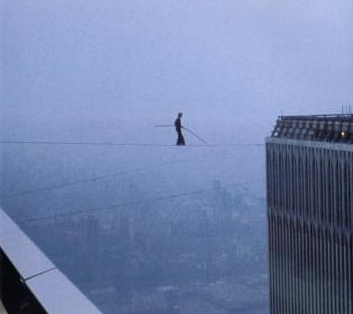Man on Wire
When on Aug. 7, 1974, Philippe Petit stepped out onto a narrow wire lashed between the World Trade Center towers, he remained a black speck in an endless morning sky. The clouds pressed low. More wind passed than desirable. The wire, one tells, was the worst they ever hung. He was 1,350 feet and the width of a cable away from a harrowing death. And he was 200 treacherous feet from his dream.
I first became aware of Petit’s dance above the clouds during a PBS documentary on the World Trade Center towers. Among the history of deal-cutting and construction woes, the story provided a fascinating five-minute human reprieve. I didn’t know I would run into it again. Seared onto the big screen and spread to ninety minutes, Man on Wire enlarges the freewheeling tale into a mesmerizing ode to the human imagination. It’s such a great film that it seems destined to be overlooked by the notoriously stingy Oscar documentary selection committee, which will probably nominate a run-of-the-mill civil rights era documentary in its place.
When writing about Man on Wire, you quickly find yourself on a wire of your own. It’s hard to find the right words to do this simple story justice. A Parisian street performer and amateur high-wire walker named Philippe Petit comes across a magazine article on the still-building Towers in a dentist’s office. With a pencil, he draws a line from the top of one to the other. A high-wire walk between the towers becomes his obsession. From that moment forward, he eats, drinks, and dreams the towers, until the day he set foot above the abyss. But that description fails to generate the human elation on display.
Early reviews correctly diagnose Man on Wire as a heist film wrapped inside a documentary, as Petit and his friends execute a plan, dodge security and commit the “artistic crime of the century.” Director James Marsh enlivens the tale with shadowy re-creations and testimony from the insanely colorful cast of conspirators. They look like they’ve walked out of the cast of Bob Le Flambeur, or some other French heist movie from the fifties. In this case, real life is so eager to mirror film convention that it gives a shady financier with a handlebar mustache. Watching him squirm to find a euphemism for criminal dealings is one the film’s priceless little moments.
But at the heart of the film are the bouncy recollections from the ants-in-the-pants Petit himself. His vivid, antic, and engrossing storytelling makes you understand why we choose to use a French word for raconteur. Through his words and those of his comrades, the film deliciously captures his desire and will – “If I die, what a beautiful death, to die in the exercise of your passion,” he announces – while also gathering the doubts felt by his girlfriend and pals, doubts that were ultimately powerless in the face of his obsession.
So you go through the quirky characters, the wild stories, the fascinating planning, the amazing ingenuity of the logistics, and eventually you think the actual wire walk will be anticlimactic. And then you get there and it’s anything but. The still photographs of Petit are mesmerizing, conveying the foolish spiritual courage of a modern quest hero. At one point, Petit – who crossed the void eight times – laid on his back and had a conversation with a baffled seagull. Then in one harrowing still photo, Marsh makes you nauseously aware of exactly how far he might have plunged to his death. Chilling and amazing.
Yet for all of the attention paid to the event itself, some of the casual joy might be found in the fresh footage – fresh both in look and in spirit – shot at the time by Petit and his band of merry men. The group often filmed their practices and planning sessions. Marsh puts a significant amount of screen time into these home movies, observing the young men and women learn the bow-and-arrow, work on the wires, and generally horse around. These sequences capture an invincible youthfulness scorched to a moment of time – an accidental slice of that-which-can-only-be-filmed. I loved every minute.
Some might complain that Man on Wire doesn’t mention the events of September 11, beyond some obscure items. Yet, at a time when we are left with only a painful, humbling memory, this film restores a beautiful moment from the beginning of its Manhattan reign – a stirring, immutable counter-memory of a day when the towers were majestic and spiritually alive. I’ve seen it said that Wong Kar-Wai’s work contemplates memory as a victory over time. That is exactly how this film treats its subject – crowning its memory as a victory over time.
news via inbox
Nulla turp dis cursus. Integer liberos euismod pretium faucibua


